ANIMAL MIGRATION
World’s migratory species in free-fall but plans under way to mitigate human harm
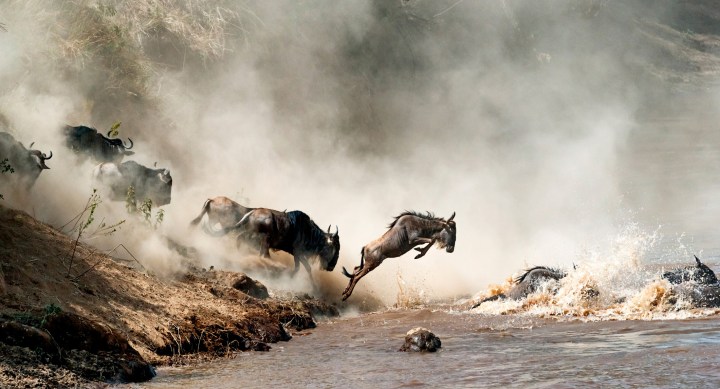
Billions of animals make migratory journeys each year, playing an essential role in maintaining the planet’s ecosystems. Now, a United Nations report reveals their survival is at risk, mainly as a result of human activities. But not all hope is lost.
The first United Nations (UN) State of the World’s Migratory Species report has found that while some migratory species are improving, nearly half (44%) are showing population declines, mainly attributed to human activities – overexploitation, habitat loss and anthropogenic climate change.
The report was launched on 12 February by the Convention on the Conservation of Migratory Species of Wild Animals (CMS) – a UN biodiversity treaty to which South Africa has been party since 1991 – at the opening of the UN wildlife conservation conference (CMS COP14) being held in Samarkand, Uzbekistan, this week.
“Migratory species rely on a variety of specific habitats at different times in their life cycles. They regularly travel, sometimes thousands of miles, to reach these places. They face enormous challenges and threats along the way, as well at their destinations where they breed or feed,” said CMS executive secretary Amy Fraenkel.
“When species cross national borders, their survival depends on the efforts of all countries in which they are found.”
Fraenkel said the landmark report, which found that more than one in five (22%) of CMS-listed species are threatened with extinction, will help underpin much-needed policy actions to ensure the survival of migratory species.
These species provide vital benefits to humans by pollinating plants, transporting key nutrients, preying on pests and helping to store carbon.
The report shows the extent to which the decline in migratory species is being caused by human activities, with the two greatest threats to migratory species being overexploitation (which includes unsustainable hunting, overfishing and the capture of non-target animals such as in fisheries), and habitat loss, degradation and fragmentation (from activities such as agriculture and the expansion of transport and energy infrastructure).
But not all hope is lost. The fact that humans are driving this looming crisis means we have the power to turn things around.
The Wildlife Conservation Society’s vice president of international policy, Susan Lieberman, said that if the 133 governments party to this treaty did everything they had committed to do, then the next “State of the World’s Migratory Species” would have some good news.
Fish in danger
The most worrying finding from the report is that nearly all CMS-listed species of fish – including migratory sharks, rays and sturgeons – are facing a high risk of extinction, with their populations declining by 90% since the 1970s.
Dr Ryan Daly, marine scientist from the Oceanographic Research Institute in Durban, told Daily Maverick that because many sharks and rays are long-lived, breed late and have few young, they can’t cope with the increasing pressure facing them from fishing, habitat loss, nursery loss (estuary degradation) and changes in food availability.
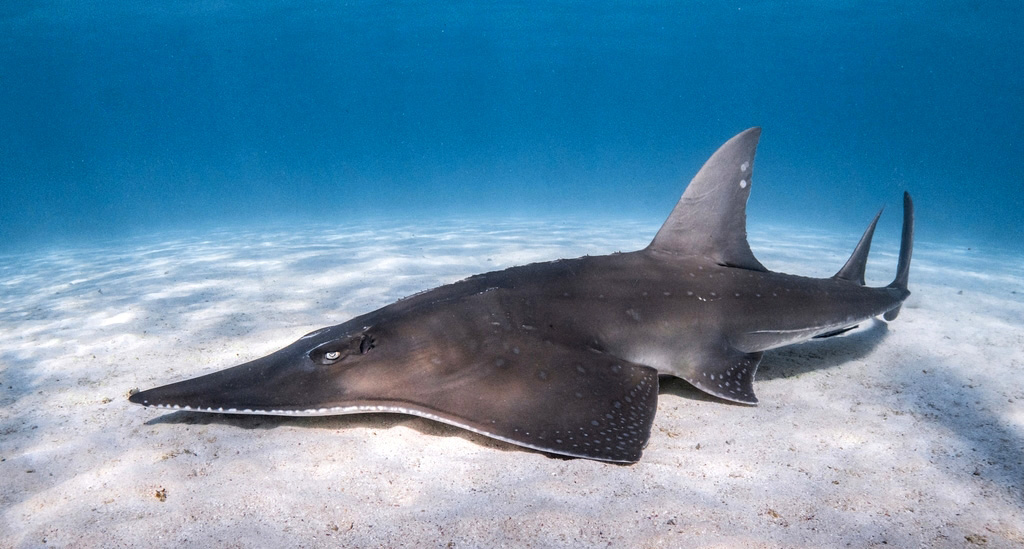
Whitespotted wedgefish have declined off South African shores by 62% over the past 40 years. (Photo: iNatutralist UK / Wikipedia)
“For some, such as the whitespotted wedgefish, it isn’t clear what is driving their decline but we know their population in South Africa has declined by 62% over the past 40 years,” said Daly.
He added that many more migratory species along our coast have become classified as endangered in our lifetime (like scalloped hammerhead, dusky shark, ragged tooth shark and many more).
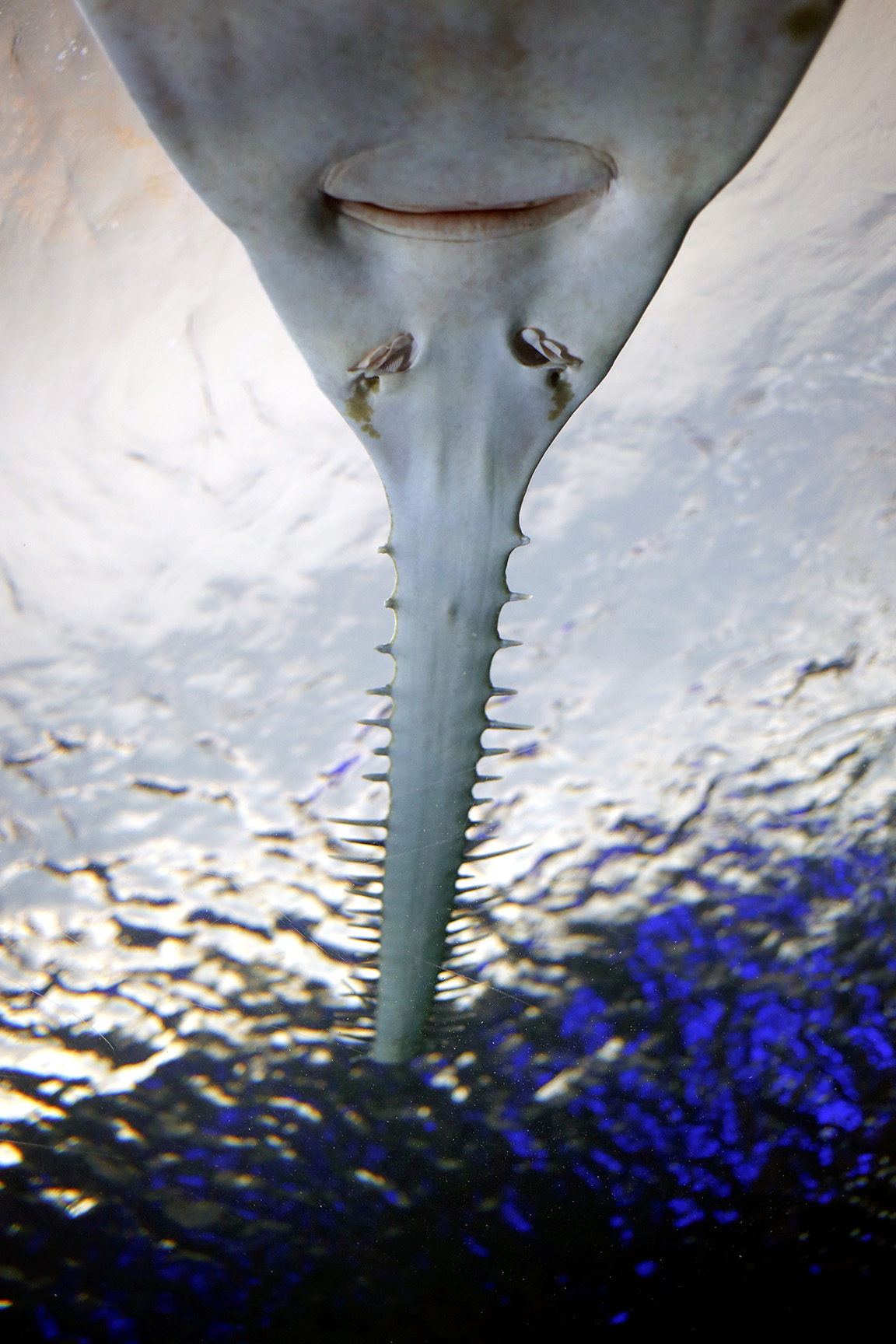
The sawfish has become extinct in South Africa during our lifetime. The report found that nearly all CMS-listed species of fish are facing a high risk of extinction. (Photo: EPA / Stephen Morrison)
The sawfish has become extinct.
Some birds under threat
While nearly all (97%) of the CMS-listed fish are threatened with extinction, according to the IUCN Red List assessment, more than three-quarters (78%) of the birds are categorised as Least Concern.
However, the report says it’s important to note that in real terms, there are still large numbers of birds (134 species, 14%) that are globally threatened.
BirdLife SA’s Flyway and Migrants Project manager, Jessica Wilmot, told Daily Maverick that South Africa’s migratory waders (waterbirds) are facing unprecedented threats, particularly along the west coast.
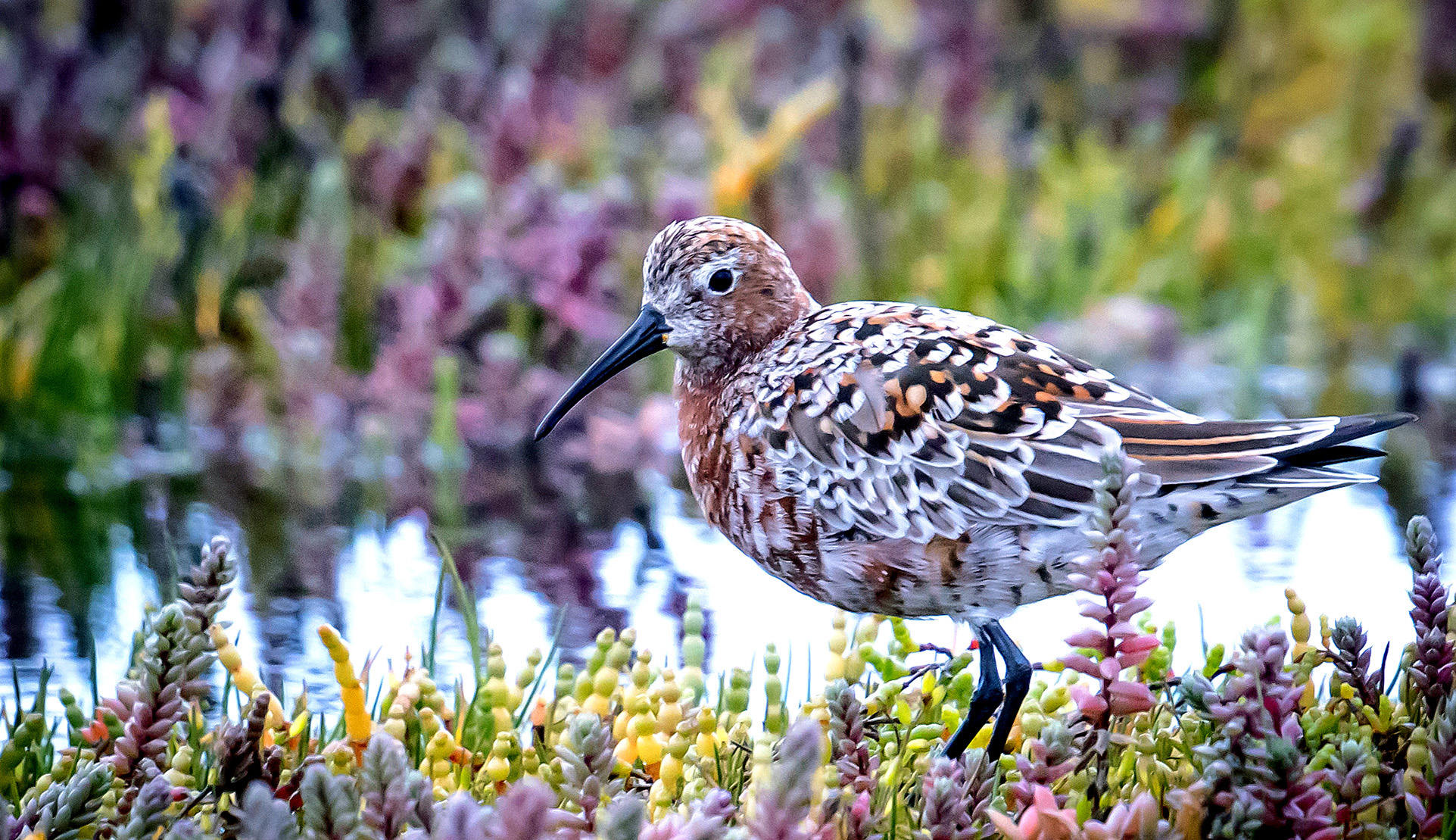
While more than three-quarters of the CMS listed birds are categorised as Least Concern, there are still large numbers that are globally threatened. (Photo: Alice Möller)
Based on the coordinated waterbird counts conducted bi-annually, BirdLife SA has found that many species – like the Sanderling, Ruddy Turnstone, Cape Cormorant and Curlew Sandpiper, to name a few – have dwindled in number.
When it comes to long-distance migratory bird species (Afro-Palearctic), Wilmot said studies have shown that many of these populations have declined over the past 50 years and that these declines have been greater than in resident species or short-distance migrants.
Wilmot said although studies were still trying to better understand this decline, there are numerous general threats found within their migratory route and at their overwintering sites. These include destruction (loss of wetlands or suitable habitat), prey-based depletion, persecution (shooting, trapping, poisoning), unintentional poisoning, electrocution/collision with energy infrastructure, and killing for food and belief-based uses.
Whales recovering
Many whale species have seen increases in their populations following the introduction of protections from commercial whaling.
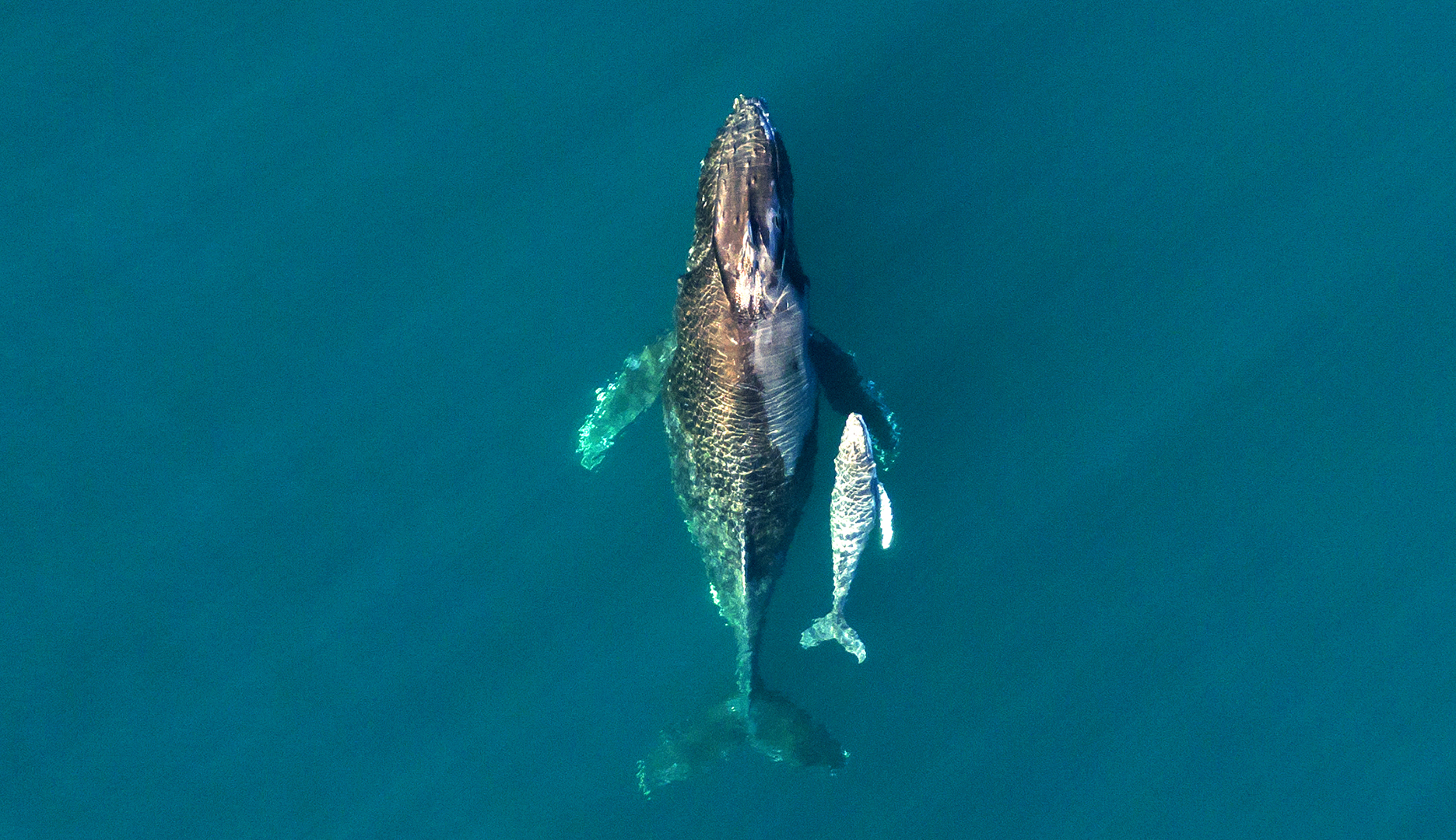
Migratory baleen whales around southern Africa include species that migrate close to shore, such as humpback whales. (Photo: iStock)
For example, the report found that the humpback whale, which was heavily hunted for its oil and baleen from the 1700s to early 1900s, has been increasing at a global level. The species is now categorised as Least Concern with an estimated global population of more than 80,000 mature individuals.
Read more in Daily Maverick: The harpoons are gone, but whales face more complex modern threats
However, the report found that “due to the isolation and genetic distinctiveness of this subpopulation and threats including entanglement in fishing gear and ship strikes,” a Concerted Action for Humpback Whales of the Arabian Sea had to be adopted at previous CMS conferences.
Dr Els Vermeulen, the research manager of the Mammal Research Institute Whale Unit at the University of Pretoria, agreed that the largest threat to migratory baleen whales around southern Africa (species that migrate close to shore, like southern right whales and humpback whales), related to shipping and underwater noise pollution, as well as climate change –which is impacting their food availability in the Southern Ocean.
Climate change and habitat loss
The report found that the two greatest threats to CMS-listed and all migratory species are overexploitation and habitat loss due to human activity and that climate change, pollution and invasive species are having profound impacts on migratory species.
Wilmot said that habitat loss and overexploitation are intensifying, and are exacerbated by climate change.
Read more in Daily Maverick: ‘Devastating’ death of dozens of migrating birds across SA points to coming climate change havoc — experts
“The most important factor is retaining suitable habitat throughout the migration route,” explained Wilmot.
“Recent tracking studies have revealed that several species wintering in southern Africa pass through western Africa on their spring migration route. This emphasises the importance of ensuring areas within western Africa are protected to support (ie providing resources, whether that’s food or a place to rest) these species.
Daly said that currently, threats from industrial fishing are driving the decline of most open ocean migratory species.
Closer to home, the shark nets in KZN are adding to the pressure from commercial fishing. The loss of function in some key nursery areas like St Lucia adds to the pressure.
Vermeulen says that while our knowledge of toothed migratory cetacean species (like killer whales, beaked whales, sperm whales, etc) is limited, she said that, “As with most marine species, anthropogenic pressures affecting them would relate to fishing pressure (decrease of prey availability and bycatch), noise and chemical pollution and shipping lanes.”
When it comes to climate change, the report found: “In addition to increasing temperatures, climate change will result in changes in precipitation, extreme weather, sea level rise and ocean acidification, all of which have the potential to dramatically change habitats and their species composition.”
Daly said that while it’s not easy to say exactly how climate change is affecting sharks, “for species that migrate each summer (like bull sharks to the end of their distributional limit), climate change may cause intense heat waves followed by upwelling events where the temperature drops suddenly, resulting in their stranding in water too cold to survive.”
“With climate change, we are seeing effects on sea ice which has detrimental effects on the recruitment of Antarctic krill, the key species of the Antarctic food web,” said Vermeulen.
“This in turn has effects on baleen whale foraging abilities and therefore reproduction.”
Read more in Daily Maverick: Recovering southern right whales face new challenge as crucial marginal ice diminishes in foraging grounds
Eco corridors
Wildlife or ecological corridors connect wildlife populations that would be disconnected from human structures or activity.
Rhian Berning, CEO at Eden to Addo Corridor Initiative, which aims to link ecologically important areas, said: “Here in South Africa we have a legacy of fortress conservation where protected areas are heavily fenced off, creating barriers to natural movement and migration.
“Just for a moment, cast your mind back to imagine the phenomenal migrations that must have coursed through our country – elephant, springbok, zebra, all moving in their thousands.
“And while we can’t necessarily restore those major migrations, we can enable connectivity again, between protected areas and areas of ecological significance, nature corridors that allow these essential life-giving processes to flow again as birds, mammals and reptiles move with the seasons, especially in the face of a changing climate.”
Wilmot agreed that ecological connectivity is integral to protecting migratory species, but that we need our government to help facilitate transboundary collaboration.
WWF’s Blue Corridors Project highlights how the cumulative impacts of industrial fishing, ship strikes, pollution, habitat loss and climate change are creating a hazardous and sometimes fatal obstacle course for marine species.
What should government be doing?
For marine species – expanding and strengthening Marine Protected Areas is vital, as well as securing the boundaries or corridors that go between countries, says Daly.
“Transboundary cooperation is key for coastal migratory species, as we share so many threatened species with our neighbours in Mozambique and our management objectives for these species need to be aligned,” said Daly.
Wilmot said we should integrate the various treaties/conventions to which South Africa is a signatory into our national and provincial policies.
For the CMS treaty, a new Programme of Work on Migratory Birds and Flyways will be adopted. Wilmot said it will be important how SA integrates that and supports NGOs to fulfil those international obligations.
The State of the World’s Migratory Species report issues a clear wake-up call and provides a set of priority recommendations for action. These include:
- Strengthen and expand efforts to tackle illegal and unsustainable taking of migratory species, as well as incidental capture of non-target species;
- Increase actions to identify, protect, connect and effectively manage important sites for migratory species;
- Urgently address those species in most danger of extinction, including nearly all CMS-listed fish species;
- Scale up efforts to tackle climate change, as well as light, noise, chemical and plastic pollution.
Inger Andersen, Executive Director of the UN Environment Programme, said Monday’s report “clearly shows us that unsustainable human activities are jeopardising the future of migratory species”.
“We cannot afford to delay and must work together to make the recommendations a reality.” DM





















Comments - Please login in order to comment.